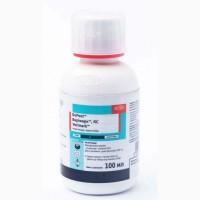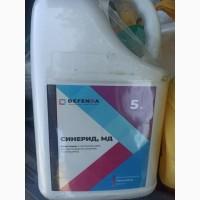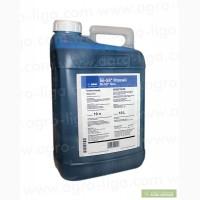/ Fertilizers and plant protection products / Insecticides / Biscay - Innovative systemic insecticide...
For sale / buy
Biscay - Innovative insecticide of systemic action against insects and pests, Kievskaya region.
Price32$
Region:all of Ukraine,
Kiev region.
(Vyshhorodok)
Updated:
Biscay® - Innovative systemic insecticide
Active substance: thiacloprid - 240 g/l
Preparative form: oil dispersion
Container: 5 l., the price is indicated for 1 l.
BENEFITS:
Non-toxicity of the active substance for bees and bumblebees.
Lack of deterrent effect for pollinators.
Excellent retention, adhesion and distribution on the leaf surface.
Increased resistance to being washed away by rain.
Improvement and acceleration of the system effect.
Maintains non-toxicity for bees when mixed with fungicides.
There are no residues in the products.
Registered for aviation use onrapeseed.
Mechanism of action:
Biscay® stimulates continuous excitation of the nervous system, which causes convulsions in insects and, as a result, death.
The drug acts both during direct contact with pests - contact action, and by eating plants treated by them (including suckingplant juice by sucking pests) - intestinal systemic action.
Translaminar effect: when it hits the plant, the active substance gradually dissolves in the oil film and, with the help of an additional substance that dissolves the wax layer, penetrates inside the plant.
Systemic effect: thanks to the ability of the active substance to move through the vessels of the plant in an upward direction, it also reaches the newly formed parts of the plant.
Antifeedant effect: a feature of the drug's effect on pests is an atypical manifestation of the "knockdown effect" - insects do not die immediately, but continue to sit on the plant. However, their feeding stops during the first hours after treatment, and the harmfulness is neutralized. The period from cessation of feeding to death shortens with increasing temperature.
Properties:
Biscay® 240 OD, MD is a unique systemic insecticide based on the active substance thiacloprid, which belongs to the chemical class of chlornicotinyls.
Features of the chemical composition of the active substance make the drug completely safe for bees, which makes it possible to use it directly during the flowering of the crop.
Biscay® is non-toxic to bees and bumblebees, both adults and larvae, and does not repel pollinators (unlike many other preparations), so the level of pollinated flowers remains as high as possible. It should be taken into account that the share of rapeseed flowers that are pollinated by insects is approximately one third.
Biscay® has a state-of-the-art preparation form — an oil dispersion specially developed using vegetable oil for the treatment of crops whose leaves have a strong waxy layer, are poorly wetted and are able to retain only a small amount of the working liquid that has fallen on it. The small size of the particles of the active substance and the presence of an oil film on the surface of the leaves greatly improve the distribution of the drug and resistance to washing off. In addition, the gradual dissolution of the active substance in the oil film ensures uniform and rapid delivery of the drug to the plant tissues.(//tractor-service.com)
When processing any crops — both with well- and poorly wetted leaves — Biscay® ensures faster penetration of the active substance into the leaves, compared to traditional preparation forms.
The systemic nature of the drug ensures a long period of protective action.
APPLICATION:
WINTER AND HOT CANOLA (including aviation processing)
Object: rape flower eater, cruciferous fleas
Drug consumption rate (l/ha): 0.3-0.4
Maximum number of treatments: 2
Application period: throughout the growing season, including flowering.
Waiting period, days: 30
Rate of consumption of working solution, l/ha: ground 100–300, aviation from 50
WINTER AND HOT CANOLA (including aviation processing)
Object: seed hidden octopus, rapeseed, aphids
Drug consumption rate (l/ha): 0.4
Maximum number of treatments: 2
Application period: throughout the growing season, including flowering.
Waiting period, days: 30
Rate of consumption of working solution, l/ha: land 100–300, air from 50
POTATO
Object: Colorado beetle
Drug consumption rate (l/ha): 0.2
Maximum number of treatments: 1
Application period: throughout the growing season, including flowering.
Waiting period, days: 20
Rate of consumption of working solution, l/ha: 100-300
Active substance: thiacloprid - 240 g/l
Preparative form: oil dispersion
Container: 5 l., the price is indicated for 1 l.
BENEFITS:
Non-toxicity of the active substance for bees and bumblebees.
Lack of deterrent effect for pollinators.
Excellent retention, adhesion and distribution on the leaf surface.
Increased resistance to being washed away by rain.
Improvement and acceleration of the system effect.
Maintains non-toxicity for bees when mixed with fungicides.
There are no residues in the products.
Registered for aviation use onrapeseed.
Mechanism of action:
Biscay® stimulates continuous excitation of the nervous system, which causes convulsions in insects and, as a result, death.
The drug acts both during direct contact with pests - contact action, and by eating plants treated by them (including suckingplant juice by sucking pests) - intestinal systemic action.
Translaminar effect: when it hits the plant, the active substance gradually dissolves in the oil film and, with the help of an additional substance that dissolves the wax layer, penetrates inside the plant.
Systemic effect: thanks to the ability of the active substance to move through the vessels of the plant in an upward direction, it also reaches the newly formed parts of the plant.
Antifeedant effect: a feature of the drug's effect on pests is an atypical manifestation of the "knockdown effect" - insects do not die immediately, but continue to sit on the plant. However, their feeding stops during the first hours after treatment, and the harmfulness is neutralized. The period from cessation of feeding to death shortens with increasing temperature.
Properties:
Biscay® 240 OD, MD is a unique systemic insecticide based on the active substance thiacloprid, which belongs to the chemical class of chlornicotinyls.
Features of the chemical composition of the active substance make the drug completely safe for bees, which makes it possible to use it directly during the flowering of the crop.
Biscay® is non-toxic to bees and bumblebees, both adults and larvae, and does not repel pollinators (unlike many other preparations), so the level of pollinated flowers remains as high as possible. It should be taken into account that the share of rapeseed flowers that are pollinated by insects is approximately one third.
Biscay® has a state-of-the-art preparation form — an oil dispersion specially developed using vegetable oil for the treatment of crops whose leaves have a strong waxy layer, are poorly wetted and are able to retain only a small amount of the working liquid that has fallen on it. The small size of the particles of the active substance and the presence of an oil film on the surface of the leaves greatly improve the distribution of the drug and resistance to washing off. In addition, the gradual dissolution of the active substance in the oil film ensures uniform and rapid delivery of the drug to the plant tissues.(//tractor-service.com)
When processing any crops — both with well- and poorly wetted leaves — Biscay® ensures faster penetration of the active substance into the leaves, compared to traditional preparation forms.
The systemic nature of the drug ensures a long period of protective action.
APPLICATION:
WINTER AND HOT CANOLA (including aviation processing)
Object: rape flower eater, cruciferous fleas
Drug consumption rate (l/ha): 0.3-0.4
Maximum number of treatments: 2
Application period: throughout the growing season, including flowering.
Waiting period, days: 30
Rate of consumption of working solution, l/ha: ground 100–300, aviation from 50
WINTER AND HOT CANOLA (including aviation processing)
Object: seed hidden octopus, rapeseed, aphids
Drug consumption rate (l/ha): 0.4
Maximum number of treatments: 2
Application period: throughout the growing season, including flowering.
Waiting period, days: 30
Rate of consumption of working solution, l/ha: land 100–300, air from 50
POTATO
Object: Colorado beetle
Drug consumption rate (l/ha): 0.2
Maximum number of treatments: 1
Application period: throughout the growing season, including flowering.
Waiting period, days: 20
Rate of consumption of working solution, l/ha: 100-300
|
Shop, contacts | |
Yuriy / отзывы, инфо. / estimate of activity | |
|
Phone:
+38(xxxxxx
show
| |
All user ads ~1000 | |
Ad ID: #992719
(added by a registered user, date registration: 10-08-2016)
Added / Updated: 14-10-2025 09:20 (current, until: 14-10-2026)
Permanent ad address:
Showed / watched for today: ?, total: ?
Similar ads
Among them there are many interesting ones...







